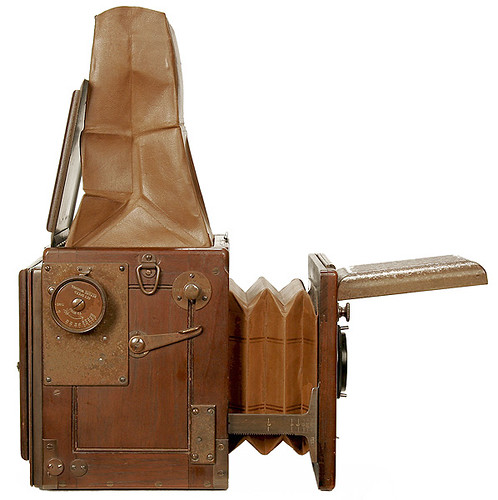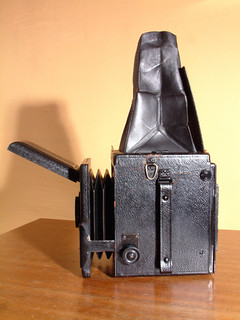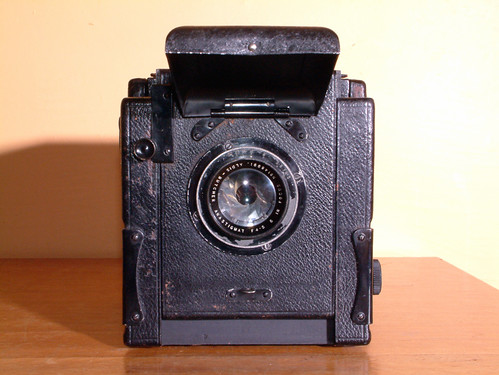Difference between revisions of "Ensign Reflex"
m (Forgot to insert a break before the links) |
m (+ref to Early Photography notes on Ensign FP shutter, and links to old adverts for the camera.) |
||
| Line 10: | Line 10: | ||
</div> | </div> | ||
{{stub}} | {{stub}} | ||
| − | The '''Ensign Reflex''', '''Ensign Deluxe Reflex''', '''Ensign Popular Reflex''' and '''Ensign Special Reflex''' are a range of large wooden-bodied box-form [[SLR]] cameras built in England by [[Houghton and Ensign|Houghton]] from about 1908 into the 1930s. They are very similar to the [[Soho Reflex]] range made by [[Marion]]. The cameras have a focal-plane shutter (typically with speeds from about 1/10 to 1/1000 second, plus 'T'; the range of speeds varies with the plate size), and no front shutter. They are designed to be used at a high waist-level (with the face applied to the top of the folding leather focusing hood to view the ground-glass screen at the top of the body), but can also be used as a view camera, with a second ground-glass screen fitted to the back. | + | The '''Ensign Reflex''', '''Ensign Deluxe Reflex''', '''Ensign Popular Reflex''' and '''Ensign Special Reflex''' are a range of large wooden-bodied box-form [[SLR]] cameras built in England by [[Houghton and Ensign|Houghton]] from about 1908 into the 1930s. They are very similar to the [[Soho Reflex]] range made by [[Marion]]. The cameras have a self-capping focal-plane shutter<ref name=EP>[http://www.earlyphotography.co.uk/site/shutterm.html#Ensign%20Focal-plane Notes on the Ensign focal-plane shutter] at [http://www.earlyphotography.co.uk/index.html Early Photography].</ref> (typically with speeds from about 1/10 to 1/1000 second, plus 'T'; the range of speeds varies with the plate size), and no front shutter. They are designed to be used at a high waist-level (with the face applied to the top of the folding leather focusing hood to view the ground-glass screen at the top of the body), but can also be used as a view camera, with a second ground-glass screen fitted to the back. |
The lens is mounted in a wooden panel on the front of the bellows, which allows a little front rise (as in the picture below). Focusing is by rack-and-pinion extension of the bellows (the rail on each side of the bellows has teeth on the bottom edge, which mesh with toothed wheels connected directly to the focusing knob on the left side). Some cameras (for example the tropical camera shown here) have focus distances engraved on the rails. The camera body is quite deep (front to back) to accommodate the mirror mechanism, so that a normal lens must be in a slightly sunken mount, almost flush with the lens board. There is a hinged metal cover over the lens, which when raised acts as a shade. | The lens is mounted in a wooden panel on the front of the bellows, which allows a little front rise (as in the picture below). Focusing is by rack-and-pinion extension of the bellows (the rail on each side of the bellows has teeth on the bottom edge, which mesh with toothed wheels connected directly to the focusing knob on the left side). Some cameras (for example the tropical camera shown here) have focus distances engraved on the rails. The camera body is quite deep (front to back) to accommodate the mirror mechanism, so that a normal lens must be in a slightly sunken mount, almost flush with the lens board. There is a hinged metal cover over the lens, which when raised acts as a shade. | ||
| − | The cameras were made in a variety of plate sizes. Tropical versions were made of some models. | + | The cameras were made in a variety of plate sizes. Tropical versions were made of some models. The cameras have a ¼-inch tripod bush in the base. |
<br style="clear:both;"/> | <br style="clear:both;"/> | ||
| Line 65: | Line 65: | ||
}} | }} | ||
<br style="clear:both;"/> | <br style="clear:both;"/> | ||
| + | |||
| + | |||
| + | ==Notes== | ||
| + | <references/> | ||
| + | |||
==Links== | ==Links== | ||
* [https://www.westlicht-auction.com/index.php?f=popup&id=260660&_ssl=off#260660 6x9 cm Ensign Special Reflex, tropical] with 12 cm f/4.5 CZJ Tessar, sold at the [https://www.westlicht-auction.com/index.php?id=246559&acat=246559&lang=3 May 2012 Westlicht Photographica Auction]. | * [https://www.westlicht-auction.com/index.php?f=popup&id=260660&_ssl=off#260660 6x9 cm Ensign Special Reflex, tropical] with 12 cm f/4.5 CZJ Tessar, sold at the [https://www.westlicht-auction.com/index.php?id=246559&acat=246559&lang=3 May 2012 Westlicht Photographica Auction]. | ||
| + | * [http://www.westlicht-auction.com/index.php?f=popup&id=190204&_ssl=off#190204 6x9 cm Ensign Special Reflex, tropical] with 5-inch f/4.5 Aldis-Butcher Anastigmat and with Ensign binocular focusing magnifier, sold at the [http://www.westlicht-auction.com/index.php?id=185090&acat=185090&offset=1&lang=3 May 2010 Westlicht auction]. | ||
| + | * [http://news.google.com/newspapers?nid=1302&dat=19161115&id=C-ZaAAAAIBAJ&sjid=HpIDAAAAIBAJ&pg=7200,3889958 Advertisement] by Harringtons Ltd of Sydney for the quarter-plate Ensign Popular Reflex (but illustrated with a picture of a [[Thornton-Pickard]] [[Ruby Reflex]]!), in the Sydney Mail, 15 November 1916; at [http://news.google.com/nwshp Google News]. | ||
| + | * [http://news.google.com/newspapers?id=UN9UAAAAIBAJ&sjid=MJIDAAAAIBAJ&pg=7034,3663677&dq=ensign+reflex&hl=en Later advertisement] also by Harringtons, and now showing the correct camera, in the Sydney Mail, 10 May 1916; also at Google News: ''For photographing stock, moving cattle, jumping horses, children, etc., etc., there is no camera at the price better than the Ensign Reflex''. | ||
| − | + | [[Category:Ensign]] [[Category:SLR]] | |
Revision as of 11:24, 15 June 2012

|
| Ensign Special Reflex, quarter-plate tropical version image by Rick Soloway (Image rights) |
The Ensign Reflex, Ensign Deluxe Reflex, Ensign Popular Reflex and Ensign Special Reflex are a range of large wooden-bodied box-form SLR cameras built in England by Houghton from about 1908 into the 1930s. They are very similar to the Soho Reflex range made by Marion. The cameras have a self-capping focal-plane shutter[1] (typically with speeds from about 1/10 to 1/1000 second, plus 'T'; the range of speeds varies with the plate size), and no front shutter. They are designed to be used at a high waist-level (with the face applied to the top of the folding leather focusing hood to view the ground-glass screen at the top of the body), but can also be used as a view camera, with a second ground-glass screen fitted to the back.
The lens is mounted in a wooden panel on the front of the bellows, which allows a little front rise (as in the picture below). Focusing is by rack-and-pinion extension of the bellows (the rail on each side of the bellows has teeth on the bottom edge, which mesh with toothed wheels connected directly to the focusing knob on the left side). Some cameras (for example the tropical camera shown here) have focus distances engraved on the rails. The camera body is quite deep (front to back) to accommodate the mirror mechanism, so that a normal lens must be in a slightly sunken mount, almost flush with the lens board. There is a hinged metal cover over the lens, which when raised acts as a shade.
The cameras were made in a variety of plate sizes. Tropical versions were made of some models. The cameras have a ¼-inch tripod bush in the base.
|
|
| ||||||

|
| Detail of Ensign Reflex nameplate image by nigel_gnp (Image rights) |

|
| Focal-plane shutter settings image by nigel_gnp (Image rights) |
Notes
Links
- 6x9 cm Ensign Special Reflex, tropical with 12 cm f/4.5 CZJ Tessar, sold at the May 2012 Westlicht Photographica Auction.
- 6x9 cm Ensign Special Reflex, tropical with 5-inch f/4.5 Aldis-Butcher Anastigmat and with Ensign binocular focusing magnifier, sold at the May 2010 Westlicht auction.
- Advertisement by Harringtons Ltd of Sydney for the quarter-plate Ensign Popular Reflex (but illustrated with a picture of a Thornton-Pickard Ruby Reflex!), in the Sydney Mail, 15 November 1916; at Google News.
- Later advertisement also by Harringtons, and now showing the correct camera, in the Sydney Mail, 10 May 1916; also at Google News: For photographing stock, moving cattle, jumping horses, children, etc., etc., there is no camera at the price better than the Ensign Reflex.


